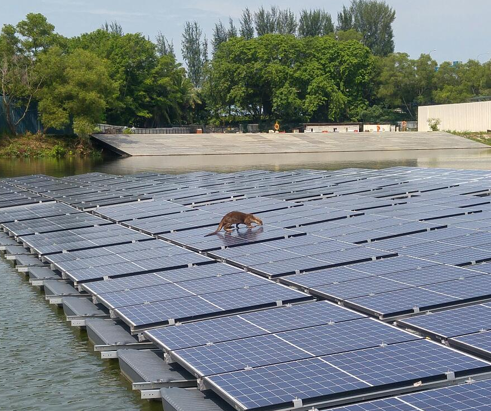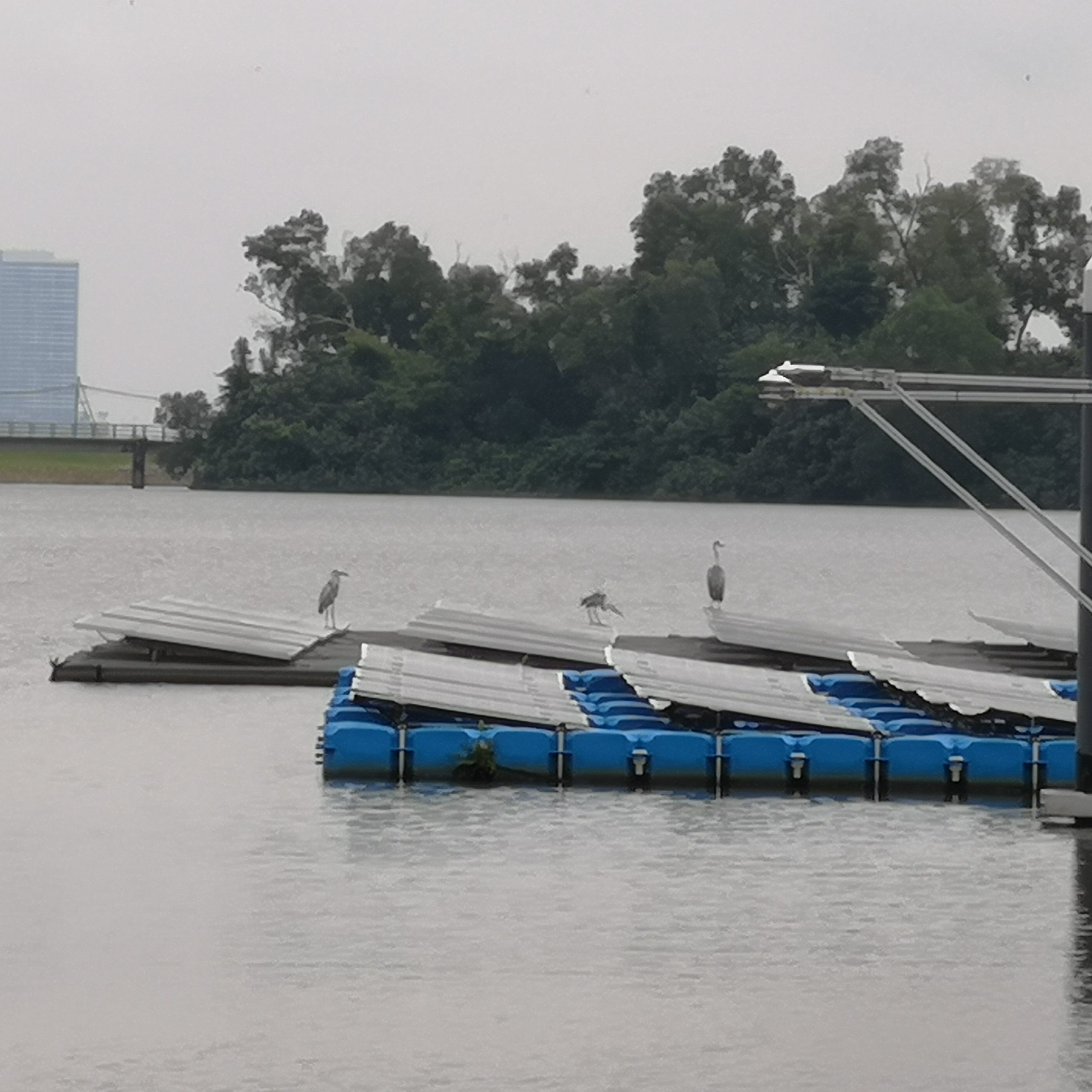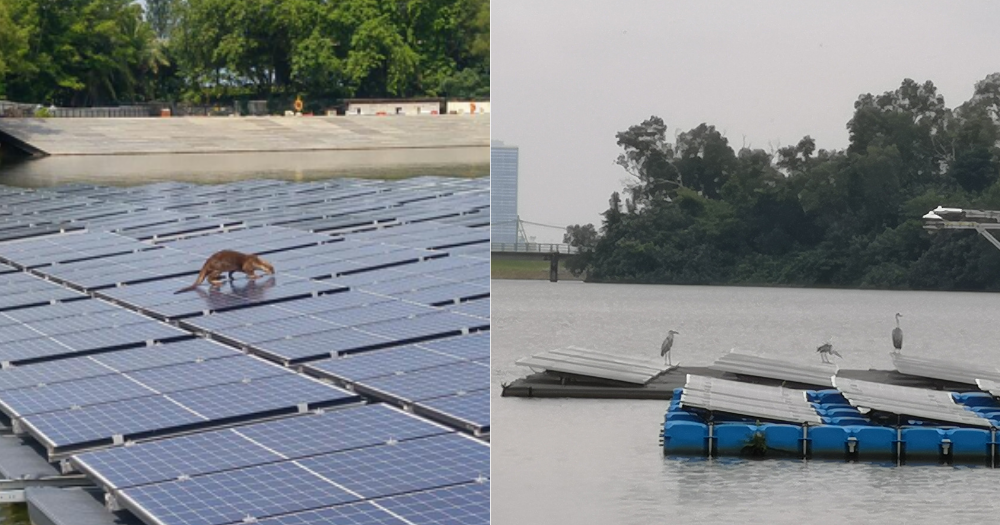Follow us on Telegram for the latest updates: https://t.me/mothershipsg
Singapore aims to increase our solar capacity by six-fold to at least two Gigawatt-peak by 2030.
That means solar energy is estimated to account for three per cent of our energy demand.
Thomas Reindl, deputy chief executive of the Solar Energy Research Institute of Singapore (SERIS) said that the collective carbon reduction from tapping solar energy is "significant", according to a 2018 Straits Times report.
As Singapore aims to harness renewable energy from the sun, it has to overcome the challenge of limited space for large-scale solar systems.
Besides vertical spaces and rooftops, another alternative space to place solar panels is on reservoirs.
Floating solar farms aim to increase S'pore's renewable energy
Tengeh Reservoir is one of the reservoirs where the construction of a floating solar system has commenced.
Spanning an area of over 32 hectares, which is the size of around 45 football fields, the solar system at Tengeh Reservoir will be one of the world's largest floating solar systems.
The energy generated from the solar farm is expected to power about 16,000 four-room HDB flats and will offset seven per cent of PUB's annual energy needs.
Other than Tengeh Reservoir, the national water agency PUB is also in the process of implementing solar systems at Bedok and Lower Seletar reservoirs.
Kranji and Upper Peirce reservoirs are potential sites as well.
Possible environmental impacts
While such solar PV systems help to reduce Singapore's dependency on fossil fuels and our carbon emissions, environmentalists have some concerns over the impacts on the flora and fauna that currently live in or around reservoirs.
Loss of foraging space for certain raptors or other wildlife
For animals that fly and hunt wildlife in the waters of the reservoir, such as the white-bellied sea eagle, it is important that the surface of the water is not covered for them to swoop down into the waters to catch prey, such as fish.
If the solar panels cover any area of the reservoir, this could reduce the amount of space they can hunt and forage in, and affect the availability of prey.
Possible impacts on water quality and ecosystem
Shawn Lum, who is a senior lecturer at the Asian School of the Environment, told Mothership how the floating solar panels impact the aquatic environment.
The panels will block sunlight from reaching the plants and phytoplankton underwater.
The plants and phytoplankton form the base of the aquatic food web can in turn affect other aquatic creatures up and down the food chain.
For example, this could lead to a reduction in large plankton which can result in fewer plankton-feeding fish and fish-feeding fish and so on, Lum said.
The die-off can also lead to a release in carbon dioxide, Lum said:
"If the shading is pervasive enough, the initial die off of plants and plankton, and, eventually, other (and larger) organisms, the initial die off could release a considerable amount of carbon dioxide following decomposition of this aquatic life."
Dead plant matter could increase the nutrient levels, such as phosphorus and nitrogen, in the water and lead to an increase in algae. This could lead to an increase in treatment costs of the water in the reservoirs.
Birds or bats crashing into the panels
Lum also added that the floating panels could pose a collision risk to bats, especially those that feed above the water or underwater.
Adding on to that, due to the reflections from the solar panels on the surface of the water, animals that are hunting might mistake for the water's surface.
The presence of solar panels on the surface of the water could limit the movement of animals such as monitor lizards and snakes. This could also prevent animals from moving across the reservoirs to mate, or find food.
Upper Peirce Reservoir should not be used
Wildlife activist Vilma D'Rozario told Mothership that she is worried about a potential floating solar project in the Upper Peirce Reservoir, as it is part of the Central Catchment Nature Reserve.
The proposed floating solar system will take up two per cent of the reservoir surface coverage.
Vilma explained that the impacts of the floating solar panels on the ecology and the environment in the nature reserves are largely unknown.
For example, it is not known how the glare from the solar panels might affect flora and fauna in the surrounding areas or affect the temperature around the panels.
Whether the impact is big or small, she told Mothership that there should not be any developments in the nature reserve.
The nature group has previously counselled against building floating solar panels at Upper Peirce Reservoir.
Wildlife found resting on solar PV systems in Tengeh Reservoir: PUB
Prior to the construction of a floating solar system at Tengeh Reservoir, monitoring and studies on the environmental and biodiversity impacts were conducted.
The same process and considerations will likely apply to other similar projects prior to the start of work.
A spokesperson of the national water agency PUB told Mothership that after four years of pilot testing of the floating solar PV systems, there was "no observable change in the reservoir’s water quality and no significant impact on the reservoir’s ecosystem".
Instead, the agency was pleased to find wildlife (such as birds and otters) resting on the solar panels in Tengeh Reservoir.
Here are photos of the floating solar panels being used by wildlife:
 Photo by SERIS.
Photo by SERIS.
 Photo by SERIS.
Photo by SERIS.
Impacts were minimal
Before the solar PV testbed was set up at Tengeh Reservoir, the PUB spokesperson shared that the agency carried out an Environment Impact Study and found that there was minimal impact on the reservoir’s environment and water quality.
During the process, various stakeholders and government agencies were engaged and the development of the testbed happened with the support of the stakeholders.
Before the project was constructed by Sembcorp, PUB also required the company to develop a comprehensive Environmental Management and Mitigation Plan (EMMP).
The EMMP covered the following impacts: monitoring and management of biodiversity, water quality, air quality, micro-climates and noise pollution before, during and post-construction of the project.
Measures to mitigate potential impacts
According to the results of water quality modelling and environmental impact studies, PUB found that impacts could be mitigated with proper design and operations.
For example, aerators could be added to maintain oxygen levels in the aquatic environment of the reservoirs and that two-thirds of the reservoir's surface would be left exposed to support biodiversity.
The PUB spokesperson said:
"For instance, the PV system design can be optimised to improve airflow between the panels and the reservoir, while allowing sufficient sunlight to enter the reservoir. Additional aerators can be deployed to maintain the oxygen levels in the reservoir so as to support the ecosystem within. We have also assessed that the remaining exposed surface of the reservoir (which is about two-thirds of the reservoir’s surface) would be sufficient to support biodiversity. Nevertheless, extensive biodiversity surveys and monitoring will be carried out before, during and after the project construction."
Water quality will not be affected
PUB also assured that drinking water quality will not be affected as water from the reservoir is treated at PUB's water treatment plants and drinking water meets the World Health Organisation’s Guidelines for Drinking-water quality.
At the same time, extensive water quality monitoring will be carried out by both PUB and Sembcorp throughout the project duration.
The spokesperson added that the agency is committed to minimising the negative impacts of floating PV while reducing national dependency on fossil fuels with "best practices in installation and operation".
PUB will monitor the progress and impact of the recent floating solar projects, and look into launching more sites, in the longer term where feasible. The necessary feasibility studies which take environmental and wildlife impacts into consideration will also be conducted prior to any deployment.
Environmental impact assessments have commenced at both Kranji and Upper Peirce reservoirs
In response to Mothership's queries, both PUB and Economic Development Board (EDB) have updated that environmental impact assessments (EIAs) have commenced at both Kranji and Upper Peirce reservoirs.
The solar system at Kranji Reservoir aims to support private-sector efforts to access renewable energy.
EDB's Senior Vice President of Environmental Sustainability, Lim Wey-Len said:
"Its potential deployment presents an opportunity for Singapore-based companies to acquire the relevant project development and engineering capabilities that could support the growth of the sector, and is aligned with supporting Singapore’s climate change commitments."
The EIA at Kranji Reservoir has commenced in the last quarter of 2020 while PUB also said that the EIA at Upper Peirce Reservoir is ongoing.
EIA studies are conducted to assess the potential environmental impact of the project and inform its feasibility.
Environmental and nature groups are consulted as part of the study, PUB added.
EIA studies expected to complete in 2021
The EIA study at Kranji Reservoir is expected to take at least a year to complete and the EIA report will be available online for public viewing at the end of the study period, Lim added.
PUB will also make public the EIA report of the solar system plan at Upper Peirce Reservoir which is expected to complete later this year.
When completed, the study will recommend possible mitigation measures during the design stage, construction period and long term operation to reduce environmental impacts throughout the project life cycle, according to PUB.
PUB adds that solar energy is Singapore's most viable renewable energy source to tackle climate change and these floating solar systems are part of Singapore's efforts to halve carbon emission to 33 million tonnes by 2050.
"The project will also enhance Singapore’s water resilience and reduce our dependency on fossil fuels as our water treatment plants will soon run on clean energy," PUB stated.
Top images from SERIS
If you like what you read, follow us on Facebook, Instagram, Twitter and Telegram to get the latest updates.

